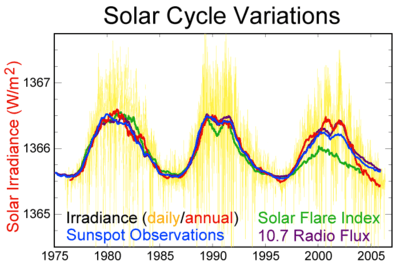Solar cycle 10
| Solar cycle 10 | |
|---|---|
 Sunspots during solar cycle 10, as sketched by [[Richard Christopher Carrington
|Richard Carrington]] (September 1, 1859). | |
| Sunspot Data | |
| Start date | December 1855 |
| End date | March 1867 |
| Duration (years) | 11.3 |
| Max count | 98.0 |
| Max count month | February 1860 |
| Min count | 5.2 |
| Spotless days | 406 |
| Cycle chronology | |
| Previous cycle | Solar cycle 9 (1843-1855) |
| Next cycle | Solar cycle 11 (1867-1878) |
Solar cycle 10 was the tenth solar cycle since 1755, when extensive recording of solar sunspot activity began.[1][2] The solar cycle lasted 11.3 years, beginning in December 1855 and ending in March 1867. The maximum smoothed sunspot number (monthly number of sunspots averaged over a twelve-month period) observed during the solar cycle was 98.0 (February 1860), and the minimum was 5.2.[3] There were a total of approximately 406 days with no sunspots during this cycle.[4][5][6]
The first observations of solar flares, by Richard Carrington and Richard Hodgson (independently), occurred during this cycle.[7]
Solar storm of 1859
On September 1–2, 1859, the largest recorded geomagnetic storm on Earth occurred, known as the Carrington Event.[7][8] Aurorae were seen around the world, even over the Caribbean; those over the Rocky Mountains were so bright that their glow awoke gold miners, who began preparing breakfast because they thought it was morning.[9]
Telegraph systems all over Europe and North America failed.[10] Telegraph pylons threw sparks and telegraph paper spontaneously caught fire. Some telegraph systems appeared to continue to send and receive messages despite having been disconnected from their power supplies.
From August 28, 1859 until September 2, numerous sunspots and solar flares were observed on the sun. Just before noon on September 1, the British astronomer Richard Carrington observed the largest flare,[7]
See also
References
- ↑ Kane, R.P. (2002). "Some Implications Using the Group Sunspot Number Reconstruction". Solar Physics 205(2), 383-401.
- ↑ "The Sun: Did You Say the Sun Has Spots?". Space Today Online. Retrieved 12 August 2010.
- ↑ SIDC Monthly Smoothed Sunspot Number. ""
- ↑ Spotless Days. ""
- ↑ What's Wrong with the Sun? (Nothing) more information: Spotless Days. ""
- ↑ Solaemon's Spotless Days Page. ""
- 1 2 3 Odenwald, Sten F.; Green, James L. (July 28, 2008). "Bracing the Satellite Infrastructure for a Solar Superstorm". Scientific American. Retrieved February 16, 2011.
- ↑ "NASA — Severe Space Weather".
- ↑ "Timeline: The 1859 Solar Superstorm".
- ↑ "The Great Storm: Solar Tempest of 1859 Revealed".
